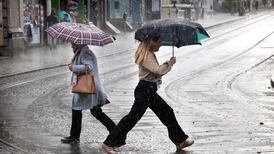Irish scientists have developed techniques to forecast red tides or algal blooms within three to four days of their occurrence. Such information could become part of daily weather forecasting - like potato blight warnings - an international conference has heard.
Speaking at the third International Shellfish Restoration conference in Cork, Dr Robin Raine, of NUI Galway, said the origin of red tides frequenting the west Cork area had already been identified. The harmful phytoplankton which posed a threat to the aquaculture industry in the south-west could be traced to a 50km patch of sea off the Cork coast.
Shifts in wind direction caused these phytoplankton to be carried by current into bays such as Bantry, where the shellfish industry is an integral part of the marine economy. A three- to four-day warning could allow shellfish farmers to market produce early, rather than face a wipeout, he said.
Satellite imagery produced in August 1998, while the Marine Institute's research vessel, Celtic Voyager was working in the area, had confirmed this scenario, Dr Raine said.
He carried out his research as part of a team supported by the Marine Institute.
Red tides or algal blooms are a worldwide problem, and are costing the US shellfish industry at least $50 million a year, Dr Dot Leonard, an environmental analyst with the US National Oceanic and Atmospheric Administration told the conference.
These blooms were naturally occurring and had always been with us, she said, pointing out that increased occurrence was more likely to be due to improved monitoring techniques. Early warning systems could be developed with the help of volunteers from the aquaculture industry, she said.
However, the "natural" theory was challenged by a fellow US researcher, Dr Sandy Shumway, of Long Island's Southampton College, who said there had been a global increase in blooms, compounded by an increase in the number of algal species. Shellfish had no universal response to the bloom threat.
Dr Shumway said the increase was due to a variety of causes, but the one common factor was increased human pressure on coastlines. Claims in Scotland that red tides could be linked to fish farming could not be supported by any evidence, she said.
Toxic shellfish had been located up to 500 miles from salmon pens, she pointed out, and phytoplankton did not use the dissolved nutrients emanating from fish farms, even in very close proximity.
A research experiment she is involved in in Maine, where scallops are being cultivated under fish cages, was proving successful, she said.
Dr Shumway said there was no hard data to pin the blame on global warming. This would be like blaming all ills within the US marine industry on El Nino.
Irish scientists intend to co-operate with the oceanic and atmospheric administration on developing remote sensing techniques to forecast red tides, the four-day conference heard. Although remote sensing would not pick up toxicity, or all types of algal blooms, it will help to improve prediction models.
Some 210 delegates from 18 countries attended the gathering, which was hosted by University College Cork's aquaculture development centre, with the support of the Marine Institute and atmospheric administration.
An Irish-US research agreement involving the institute and administration was confirmed last year during President Clinton's visit to Limerick and Kerry.







